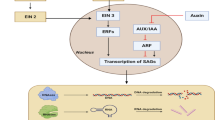Abstract.
Apart from the typical, multifaceted calcium oxalate druses distributed in the mesenchyma of Nelumbo nucifera, another, unique type of druse idioblast exists in this plant. They loosely cover the lateral surface of the obconical flower receptacle. Based on light and SEM microscopy, their structure and ontogeny are described for the first time. The crystal complex consists of a flat, usually six-rayed, sharp-pointed star positioned above, and parallel to, the epidermal surface. The idioblast is supported and elevated by six adjacent columnar epidermal cells alternating with the crystal spikes. The spikes represent individual, lamellate crystals symmetrically arranged around a core of crystal sand. In the ontogeny, six steps can be discerned: 1) Enlargement and dome-like emergence of the idioblast. 2) Appearance of vacuoles below the distal endopolyploid nucleus. 3) The vacuoles coalesce and minute crystal particles collect in the vacuole and aggregate to a cluster. 4) A small six-rayed primary druse forms at a variable position. 5) The druse migrates to the cell top, becomes strictly parallel to the epidermal surface, and while the cell head further expands, a second star complex develops, becoming superimposed on the primary druse, its spikes bulging out the thin cell wall. 6) The cytoplasm vanishes and the proximal cell section becomes compressed by the surrounding columnar cells. Because the star-like bodies are confined to the nutrient-rich receptacle, are freely exposed and easily detached, they represent specialized modifications of the internal druses and apparently serve as a deterrent against herbivory.
Similar content being viewed by others
Author information
Authors and Affiliations
Corresponding author
Additional information
The Botanical Gardens of Mainz (Custos Dr. U. Hecker) and Vienna (Chief gardener Dipl.Ing. F. Schumacher) were the source of plant material during the years. In Vienna, Dr. H. Halbritter helped with scanning electron microscopy. Dr. R. Eberwein and S. Gockner-Mayer readily resolved computer problems. Prof. Dr. A. Weber critically read earlier drafts of the manuscript and Dr. M. Stachowitsch improved the English. The author gratefully acknowledges the pleasant cooperation of all these colleagues.
Rights and permissions
About this article
Cite this article
Vogel, S. Contributions to the functional anatomy and biology of Nelumbo nucifera (Nelumbonaceae) II. Unique emergent druses on the floral receptacle. Plant Syst. Evol. 249, 27–35 (2004). https://doi.org/10.1007/s00606-004-0202-7
Received:
Accepted:
Published:
Issue Date:
DOI: https://doi.org/10.1007/s00606-004-0202-7




